3COM WL-552 User Manual

OfficeConnect®
ADSL Wireless 54 Mbps 11g Firewall
Router
User Guide
WL-552
3CRWDR101A-75 3CRWDR101B-75
http://www.3Com.com/
Part No. 10015091 Rev. AA
Published March 2006
3Com Corporation
350 Campus Drive,
Marlborough, MA
USA 01752-3064
Copyright © 2004, 2005, 2006, 3Com Corporation. All rights reserved. No part of this documentation may be reproduced in any form or by any means or used to make any derivative work (such as translation, transformation, or adaptation) without written permission from 3Com Corporation.
3Com Corporation reserves the right to revise this documentation and to make changes in content from time to time without obligation on the part of 3Com Corporation to provide notification of such revision or change.
3Com Corporation provides this documentation without warranty, term, or condition of any kind, either implied or expressed, including, but not limited to, the implied warranties, terms or conditions of merchantability, satisfactory quality, and fitness for a particular purpose. 3Com may make improvements or changes in the product(s) and/or the program(s) described in this documentation at any time.
If there is any software on removable media described in this documentation, it is furnished under a license agreement included with the product as a separate document, in the hard copy documentation, or on the removable media in a directory file named LICENSE.TXT or !LICENSE.TXT. If you are unable to locate a copy, please contact 3Com and a copy will be provided to you.
UNITED STATES GOVERNMENT LEGEND
If you are a United States government agency, then this documentation and the software described herein are provided to you subject to the following:
All technical data and computer software are commercial in nature and developed solely at private expense. Software is delivered as “Commercial Computer Software” as defined in DFARS 252.227-7014 (June 1995) or as a “commercial item” as defined in FAR 2.101(a) and as such is provided with only such rights as are provided in 3Com’s standard commercial license for the Software. Technical data is provided with limited rights only as provided in DFAR 252.227-7015 (Nov 1995) or FAR 52.227-14 (June 1987), whichever is applicable. You agree not to remove or deface any portion of any legend provided on any licensed program or documentation contained in, or delivered to you in conjunction with, this User Guide.
Unless otherwise indicated, 3Com registered trademarks are registered in the United States and may or may not be registered in other countries.
3Com, and the 3Com logo are registered trademarks of 3Com Corporation.
Intel and Pentium are registered trademarks of Intel Corporation. Microsoft, MS-DOS, Windows, and Windows NT are registered trademarks of Microsoft Corporation. Novell and NetWare are registered trademarks of Novell, Inc. UNIX is a registered trademark in the United States and other countries, licensed exclusively through X/Open Company, Ltd.
Netscape Navigator is a registered trademark of Netscape Communications.
JavaScript is a trademark of Sun Microsystems
Wi-Fi and the Wi-Fi logo are registered trademarks of the WI-Fi Alliance.
IEEE and 802 are trademarks of the Institute of Electrical and Electronics Engineers, Inc.
All other company and product names may be trademarks of the respective companies with which they are associated.
ENVIRONMENTAL STATEMENT
It is the policy of 3Com Corporation to be environmentally-friendly in all operations. To uphold our policy, we are committed to:
Establishing environmental performance standards that comply with national legislation and regulations.
Conserving energy, materials and natural resources in all operations.
Reducing the waste generated by all operations. Ensuring that all waste conforms to recognized environmental standards. Maximizing the recyclable and reusable content of all products.
Ensuring that all products can be recycled, reused and disposed of safely.
Ensuring that all products are labelled according to recognized environmental standards.
Improving our environmental record on a continual basis.
End of Life Statement
3Com processes allow for the recovery, reclamation and safe disposal of all end-of-life electronic components.
Regulated Materials Statement
3Com products do not contain any hazardous or ozone-depleting material.
Environmental Statement about the Documentation
The documentation for this product is printed on paper that comes from sustainable, managed forests; it is fully biodegradable and recyclable, and is completely chlorine-free. The varnish is environmentally-friendly, and the inks are vegetable-based with a low heavy-metal content.

CONTENTS
ABOUT THIS GUIDE
Naming Convention 7
Conventions 8
Feedback About This User Guide 8
Related Documentation 9
1 INTRODUCING THE ROUTER
OfficeConnect ADSL Wireless 54 Mbps 11g Firewall Router 11
|
Router Advantages 13 |
|
|
|
Package Contents |
13 |
|
|
Minimum System and Component Requirements 14 |
||
|
Physical Features |
14 |
|
|
|
||
2 INSTALLING THE ROUTER |
|||
|
Introduction 17 |
|
|
|
Safety Information |
17 |
|
|
Positioning the Router |
17 |
|
|
Using the Rubber Feet 18 |
||
|
Wall Mounting |
18 |
|
|
Powering Up the Router |
19 |
|
|
Connecting the Router |
19 |
|
3 SETTING UP YOUR COMPUTERS
Obtaining an IP Address Automatically 23
Windows 2000 |
23 |
|
Windows XP |
25 |
|
Windows 98/ME |
25 |
|
Macintosh |
25 |
|
Disabling PPPoE and PPTP Client Software 26 |
||
Disabling Web Proxy |
26 |
|

4 RUNNING THE SETUP WIZARD
Accessing the Setup Wizard 27 |
|
Setup Wizard - Change Password |
30 |
Setup Wizard - Time and Time Zone 30 |
|
Setup Wizard - Connection Type |
31 |
Setup Wizard - LAN Settings 36 |
|
Setup Wizard - Wireless Settings |
37 |
Setup Wizard - Configuration Summary 38 |
|
5 CONFIGURING THE ROUTER
Navigating Through the Router Configuration screens 39
Main Menu |
|
39 |
|
|
Welcome Screen |
39 |
|
||
Status |
39 |
|
|
|
LAN Settings |
40 |
|
||
LAN Settings |
40 |
|
||
DHCP Clients List |
41 |
|||
Wireless Settings |
43 |
|
||
Configuration |
44 |
|
||
Encryption |
45 |
|
||
Connection Control |
50 |
|||
Client List |
51 |
|
||
WDS Settings |
51 |
|
||
Advance |
52 |
|
|
|
Profile 53 |
|
|
||
Internet Settings |
54 |
|
||
ATM PVC |
54 |
|
||
DNS |
65 |
|
|
|
Hostname & Clone MAC address 66 |
||||
Firewall |
67 |
|
|
|
SPI |
67 |
|
|
|
Special Applications |
71 |
|||
Virtual Servers |
72 |
|
||
DMZ |
73 |
|
|
|

Schedule Rule |
|
74 |
||
PC Privileges |
75 |
|||
URL Filter |
77 |
|
|
|
Server Control |
|
79 |
||
Quality of Service |
|
81 |
||
QoS Settings |
81 |
|||
Traffic Mapping |
81 |
|||
Traffic Statistics |
|
82 |
||
Advanced 83 |
|
|
||
Security |
83 |
|
|
|
Static Routes |
86 |
|||
RIP |
87 |
|
|
|
DDNS |
88 |
|
|
|
SNMP |
90 |
|
|
|
Syslog |
91 |
|
|
|
Proxy ARP |
92 |
|
||
System Tools |
93 |
|
|
|
Restart Router |
|
93 |
||
Configuration |
|
93 |
||
Upgrade |
94 |
|
|
|
Time Zone |
95 |
|
||
Ping |
96 |
|
|
|
Traceroute |
97 |
|
||
DNS Lookup |
98 |
|||
Status and Logs |
99 |
|||
Status |
99 |
|
|
|
ADSL Status |
99 |
|||
ATM PVC Status |
100 |
|||
Routing Table |
|
100 |
||
Logs |
101 |
|
|
|
Support/Feedback |
|
102 |
||
Support |
102 |
|
|
|
Feedback |
102 |
|
||
6 TROUBLESHOOTING
Basic Connection Checks 103
Browsing to the Router Configuration Screens 103

|
Connecting to the Internet |
104 |
|
Forgotten Password and Reset to Factory Defaults 104 |
|
|
Wireless Networking 105 |
|
|
Recovering from Corrupted Software 107 |
|
|
Frequently Asked Questions |
108 |
|
|
|
A IP ADDRESSING |
|
|
|
The Internet Protocol Suite |
109 |
|
Managing the Router over the Network 109 |
|
|
|
IP Addresses and Subnet Masks 109 |
|
|
|
How does a Device Obtain an IP Address and Subnet Mask? |
111 |
|
|
DHCP Addressing |
111 |
|
|
Static Addressing |
111 |
|
|
Auto-IP Addressing |
111 |
|
|
|
|
|
B TECHNICAL SPECIFICATIONS |
|
||
|
OfficeConnect ADSL Wireless 54Mbps 11g Firewall Router |
113 |
|
|
Standards 114 |
|
|
CSAFETY INFORMATION
DEND USER SOFTWARE LICENSE AGREEMENT
EOBTAINING SUPPORT FOR YOUR PRODUCT
Register Your Product |
123 |
|
Purchase Value-Added Services |
123 |
|
Troubleshoot Online |
124 |
|
Access Software Downloads |
124 |
|
Telephone Technical Support and Repair 124
Contact Us 125

GLOSSARY
REGULATORY NOTICES
INDEX

ABOUT THIS GUIDE
This guide describes how to install and configure the 3Com OfficeConnect© ADSL Wireless 54 Mbps 11g Firewall Router (3CRWDR101A-75/3CRWDR101B-75).
This guide is intended for use by those responsible for installing and setting up network equipment; consequently, it assumes a basic working knowledge of LANs (Local Area Networks) and Internet Routers.
If a release note is shipped with the 3Com OfficeConnect ADSL Wireless 54 Mbps 11g Firewall Router and contains information that differs from the information in this guide, follow the information in the release note.
Most user guides and release notes are available in Adobe Acrobat Reader Portable Document Format (PDF) on the 3Com World Wide Web site:
http://www.3Com.com
Naming Convention Throughout this guide, the 3Com OfficeConnect© ADSL Wireless 54 Mbps 11g Firewall Router is referred to as the “Router”.
Category 3 and Category 5 Twisted Pair Cables are referred to as Twisted
Pair Cables throughout this guide.
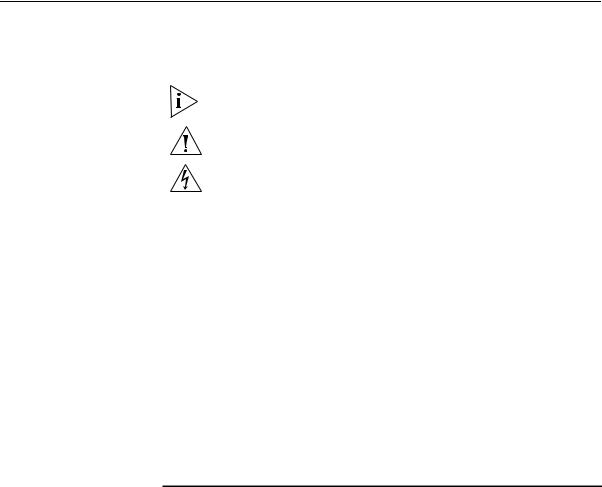
8 ABOUT THIS GUIDE
Conventions |
Table 1 and Table 2 list conventions that are used throughout this guide. |
||
|
Table 1 |
Notice Icons |
|
|
|
|
|
|
Icon |
Notice Type |
Description |
|
|
|
|
|
|
Information note Information that describes important features or |
|
|
|
|
instructions. |
|
|
Caution |
Information that alerts you to potential loss of data or |
|
|
|
potential damage to an application, system, or device. |
|
|
Warning |
Information that alerts you to potential personal |
|
|
|
injury. |
|
|
|
|
|
Table 2 |
Text Conventions |
|
|
|
|
|
|
Convention |
Description |
|
|
|
|
|
|
The words “enter” |
When you see the word “enter” in this guide, you must type |
|
|
and “type” |
something, and then press Return or Enter. Do not press |
|
|
|
|
Return or Enter when an instruction simply says “type.” |
|
|
|
|
|
Keyboard key names |
If you must press two or more keys simultaneously, the key |
|
|
|
|
names are linked with a plus sign (+). Example: |
|
|
|
Press Ctrl+Alt+Del |
|
|
|
|
|
Words in italics |
Italics are used to: |
|
|
|
|
■ Emphasize a point. |
■ Denote a new term at the place where it is defined in the text.
■ Identify menu names, menu commands, and software button names. Examples:
From the Help menu, select Contents.
Click OK.

Feedback About This User Guide |
9 |
Feedback About Your suggestions are very important to us. They will help make our This User Guide documentation more useful to you. Please e-mail comments about this
document to 3Com at:
pddtechpubs_comments@3com.com
Please include the following information when commenting:
■Document title
■Document part number (on the title page)
■Page number (if appropriate)
Example:
■3Com OfficeConnect ADSL Wireless 54Mbps 11g Firewall Router User Guide
■Part Number 10015091 Rev. AA
■Page 24
Do not use this e-mail address for technical support questions. For information about contacting Technical Support, please refer to Appendix C.
Related |
In addition to this guide, each Router document set includes one |
Documentation |
Installation Guide. This guide contains the instructions you need to install |
|
and configure your Router. |
10 ABOUT THIS GUIDE

1 |
INTRODUCING THE ROUTER |
|
Welcome to the world of networking with 3Com®. In the modern business environment, communication and sharing information is crucial. Computer networks have proved to be one of the fastest modes of communication but, until recently, only large businesses could afford the networking advantage.
OfficeConnect ADSL The OfficeConnect ADSL Wireless 54 Mbps 11g Firewall Router is Wireless 54 Mbps designed to provide a cost-effective means of sharing a single broadband 11g Firewall Router Internet connection amongst several wired and wireless computers. The
Router also provides protection in the form of an electronic “firewall” preventing anyone outside of your network from seeing your files or damaging your computers. The Router can also prevent your users from accessing Web sites which you find unsuitable.
Figure 1 shows an example network without a Router. In this network, only one computer is connected to the Internet. This computer must always be powered on for the other computers on the network to access the Internet.
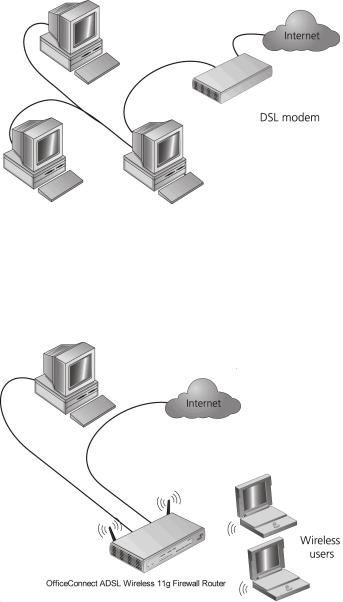
12 CHAPTER 1: INTRODUCING THE ROUTER
Figure 1 Example Network Without a Router
When you use the Router in your network (Figure 2), it becomes your connection to the Internet. Connections can be made directly to the Router, or to an OfficeConnect Switch or Hub, expanding the number of computers you can have in your network.
Figure 2 Example Network Using a Firewall Router

Router Advantages 13
Router Advantages The advantages of the Router include:
■Shared Internet connection for both wired and wireless computers
■High speed 802.11g wireless networking
■No need for a dedicated, “always on” computer serving as your Internet connection
■Cross-platform operation for compatibility with Windows, Unix and Macintosh computers
■Easy-to-use, Web-based setup and configuration
■Provides centralization of all network address settings (DHCP)
■Acts as a Virtual server to enable remote access to Web, FTP, and other services on your network
■Security — Firewall protection against Internet hacker attacks and encryption to protect wireless network traffic
Package Contents The Router kit includes the following items:
■One OfficeConnect ADSL Wireless 54Mbps 11g Firewall Router
■One power adapter for use with the Router
■Four rubber feet
■One Telephone Cable
■One CD-ROM containing this User Guide
■Installation Guide
■One Support and Safety Information Sheet
■One Warranty Flyer
If any of these items are missing or damaged, please contact your retailer.
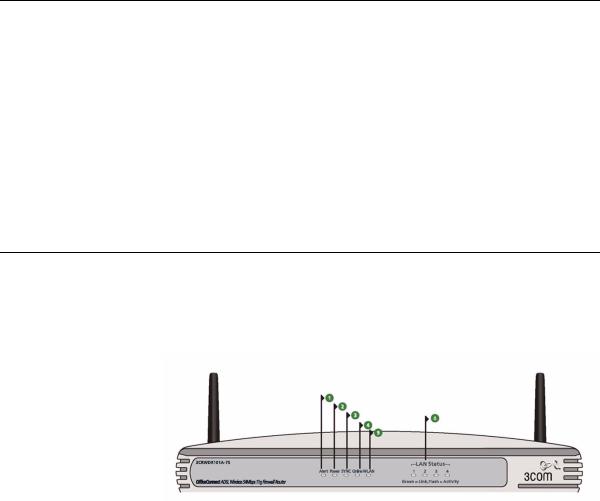
14 CHAPTER 1: INTRODUCING THE ROUTER
Minimum System
and Component
Requirements
Your Router requires that the computer(s) and components in your network be configured with at least the following:
■A computer with an operating system that supports TCP/IP networking protocols (for example Windows 98/NT/Me/2000/XP, Unix, Mac OS 8.5 or higher).
■An Ethernet 10 Mbps or 10/100 Mbps NIC for each computer to be connected to the four-port switch on your Router.
■An 802.11b or 802.11g wireless NIC.
■An active ADSL subscription and connection.
■A Web browser that supports JavaScript, such as Netscape 4.7 or higher, Internet Explorer 5.0 or higher, or Mozilla 1.2.1 or higher.
Physical Features The front panel of the Router contains a series of indicator lights (LEDs) that help describe the state of various networking and connection operations.
Figure 3 Router - Front Panel
1Alert LED
Orange
Fast flash during self test. If self test fails the LED will remain on. Fast flash during software upgrade.
Fast flash for software reset to the factory defaults. Fast flash for hardware reset to the factory defaults.
The LED is on for 2 seconds when the firewall detects a hacker attack.
Physical Features 15
2Power LED
Green
Indicates that the Router is powered on, and the boot up is successful.
3SYNC LED
Green
If the LED is on it indicates that DSL connection is present. This LED flashes during configuration at power up.
4Online LED
Green
If this LED is on, your username/password has been authenticated successfully with your ISP.
5Wireless LAN (WLAN) Status LED
Green
If the LED is on it indicates that wireless networking is enabled. If the LED is flashing, the link is OK and data is being transmitted or received. If the LED is off, the Wireless LAN has been disabled in the Router, or there is a problem. Refer to Chapter 6 “Troubleshooting”.
6LAN Status LEDs
Green
If the LED is on, the link between the port and the next piece of network equipment is OK. If the LED is flashing, the link is OK and data is being transmitted or received. If the LED is off, nothing is connected, or the connected device is switched off, or there is a problem with the connection (refer to Chapter 6 “Troubleshooting”). The port will automatically adjust to the correct speed and duplex.
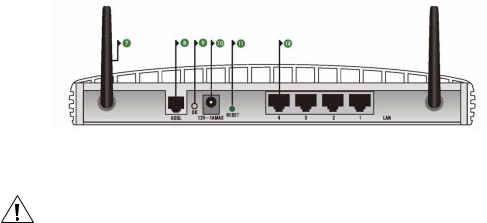
16 CHAPTER 1: INTRODUCING THE ROUTER
The rear panel (Figure 4) of the Router contains four LAN ports, one ADSL port, a reset button, a power OK LED, and a power adapter socket.
Figure 4 Router - Rear Panel
7Wireless Antennae
The antennae should be placed in a ‘V’ position when initially installed.
CAUTION: Do not force the antennae beyond their mechanical stops.
Rotating the antennae further may cause damage.
8ADSL Port
Using the RJ-11 cable provided, you should connect your Router to the telephone socket via a splitter.
9Power OK LED
Indicates the Router is powered on, the power adapter is working properly.
10Power Adapter Socket
Only use the power adapter that is supplied with this Router. Do not use any other adapter.
11Reset Button
If you want to reset your Router to factory default settings, and cannot access the web management interface (for example, due to a lost password), then you may use this button. Refer to “Forgotten Password and Reset to Factory Defaults” on page 104 for further details.
12Ethernet Ports
Using suitable RJ-45 cables, you can connect your Router to a computer, or to any other piece of equipment that has an Ethernet connection (for example, a hub or a switch). These ports have an automatic MDI/MDIX feature, which means either straight-through or a crossover cable can be used.

2 |
INSTALLING THE ROUTER |
|
Introduction |
This chapter will guide you through a basic installation of the Router, |
|
including: |
|
■ Connecting the Router to the Internet. |
|
■ Connecting the Router to your network. |
|
■ Setting up your computers for networking with the Router. |
Safety Information |
Please note the following: |
|
WARNING: Please read the “Safety Information” section in Appendix C |
|
before you start. |
|
VORSICHT: Bitte lesen Sie den Abschnitt “Wichtige Sicherheitshinweise” |
|
sorgfältig durch, bevor Sie das Gerät einschalten. |
|
AVERTISSEMENT: Veuillez lire attentivement la section “Consignes |
|
importantes de sécurité” avant de mettre en route. |
Positioning the
Router
You should place the Router in a location that:
■is conveniently located for connection to the telephone socket.
■is centrally located to the wireless computers that will connect to the Router. A suitable location might be on top of a high shelf or similar furniture to optimize wireless connections to computers in both horizontal and vertical directions, allowing wider coverage.
■allows convenient connection to the computers that will be connected to the four LAN ports on the rear panel, if desired.
■allows easy viewing of the front panel LED indicator lights, and access to the rear panel connectors, if necessary.

18 CHAPTER 2: INSTALLING THE ROUTER
When positioning your Router, ensure:
■It is out of direct sunlight and away from sources of heat.
■Cabling is away from power lines, fluorescent lighting fixtures, and sources of electrical noise such as radios, transmitters and broadband amplifiers.
■Water or moisture cannot enter the case of the unit.
■Air flow around the unit and through the vents in the side of the case is not restricted. 3Com recommends you provide a minimum of
25 mm (1 in.) clearance.
Using the Rubber Use the four self-adhesive rubber feet to prevent your Router from Feet moving around on your desk or when stacking with flat top units. Only
stick the feet to the marked areas at each corner of the underside of your Router.
Wall Mounting |
There are two slots on the underside of the Router that can be used for |
|
wall mounting. |
|
When wall mounting the unit, ensure that it is within reach of the power |
|
outlet. |
|
You will need two suitable screws to wall mount the unit. To do this: |
1Ensure that the wall you use is smooth, flat, dry and sturdy and make two screw holes which are 150 mm (5.9 in.) apart.
2Fix the screws into wall, leaving their heads 3 mm (0.12 inch) clear of the wall surface.
3Remove any connections to the unit and locate it over the screw heads. When in line, gently push the unit on to the wall and move it downwards to secure.
When making connections, be careful not to push the unit up and off the wall.
CAUTION: Only wall mount single units, do not wall mount stacked units.

Powering Up the Router 19
Powering Up the |
To power up the Router: |
Router |
|
1 Plug the power adapter into the power adapter socket located on the |
||||||||||||||||
|
back panel of the Router. |
|
|
|
|
|
|
|
||||||||
2 Plug the power adapter into a standard electrical wall socket. |
||||||||||||||||
3 Press the power button located on the back of the Router. |
||||||||||||||||
|
|
|
|
|
|
|
|
|
|
|
|
|
|
|
|
|
Connecting the |
The first step for installing your Router is to physically connect it to the |
|||||||||||||||
Router |
telephone socket and then connect it to a computer in order to be able to |
|||||||||||||||
|
access the Internet. See Figure 5: |
|||||||||||||||
|
Figure 5 Connecting the Router |
|||||||||||||||
|
|
|
|
Internet |
|
|
|
|
|
|
|
|||||
|
Power |
|
|
|
|
|
|
|
||||||||
|
Supply Unit |
3Com OfficeConnect |
||||||||||||||
|
|
|
|
|
|
|
|
|
|
|||||||
|
|
Telephone |
|
|
|
|
ADSL Wireless 11g Firewall Router |
|
||||||||
|
Socket |
|
|
|
|
|
|
|
||||||||
|
|
|
|
|
|
|
|
|
|
|
|
|
|
|
|
|
|
|
|
|
|
|
|
|
|
|
|
|
|
|
|
|
|
|
|
Splitter/ |
|
|
|
|
|
|
|
|||||||
|
|
|
|
|
|
|
|
|
|
|
|
|
|
|||
|
|
Microfilter Block |
|
|
|
|
|
|
|
|||||||
|
|
|
|
|
|
|
|
|
|
|
|
|
|
|
|
|
|
|
|
|
|
|
|
|
|
|
|
|
|
|
|||
|
|
|
|
Your PC |
|
|
|
|
|
|
|
|||||
|
|
|
|
|
|
|
|
|
|
|
|
|
|
|
|
|
|
|
|
|
|
|
|
|
|
|
Wireless |
||||||
|
|
|
|
|
|
|
|
|
|
|
|
|
|
|
||
|
|
|
|
|
|
|
|
|
|
Users |
||||||
1 Run the provided telephone cable from the wall jack providing ADSL |
||||||||||||||||
|
service to the ADSL port on your Router. When inserting an ADSL RJ-11 |
|||||||||||||||
|
plug, be sure the tab on the plug clicks into position to ensure that it is |
|||||||||||||||
|
properly seated. If you are using splitterless ADSL service, add low-pass |
|||||||||||||||
|
filters between the ADSL wall jack and your telephones. (These filters pass |
|||||||||||||||
|
voice signals through but filter data signals out.) |
|||||||||||||||
2 |
Then: |
|
|
|
|
|
|
|
||||||||
|
■ If you are using a full-rate (G.dmt) connection, your service provider |
|||||||||||||||
will attach the outside ADSL line to a data/voice splitter. In this case
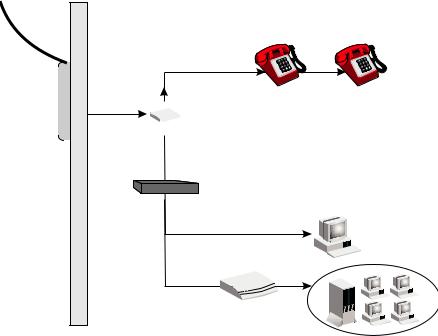
20 CHAPTER 2: INSTALLING THE ROUTER
you can connect your phones and computer directly to the splitter as shown below (Figure 6):
or
■If you are using a splitterless (G.lite) connection, then your service provider will attach the outside ADSL line directly to your phone system. In this case you can connect your phones and computer directly to the incoming ADSL line, but you will have to add low-pass filters to your phones as shown below (Figure 7)
Figure 6 Installing with a splitter
Plain Old
Telephone
System (POTS)
Residential |
Voice |
|
|
Connection |
|
Point (NID) |
|
Splitter
Data
Router
or
Ethernet hub or switch
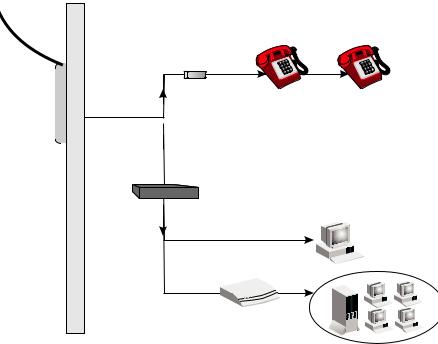
Connecting the Router |
21 |
Figure 7 Installing without a splitter
Plain Old
Telephone
System (POTS)
Voice
Residential |
Voice |
Filter |
Connection |
|
|
Point [Network |
& Data |
|
Interface |
|
|
Device (NID)] |
|
|
Voice
& Data
Router
Data
or
Ethernet hub or switch
You have now completed the hardware installation of your Router. Next you need to set up your computers so that they can make use of the Router to communicate with the Internet.
3Com recommends that you perform the initial Router configuration from a computer that is directly connected to one of the LAN ports.
If you configure the Router from a wireless computer, note that you may lose contact with the Router if you change the wireless configuration.
To communicate wirelessly with your Router, your wireless NIC should be set as follows:
■Encryption — none
■SSID — 3Com
■Channel — 11
22 CHAPTER 2: INSTALLING THE ROUTER

3 |
SETTING UP YOUR COMPUTERS |
|
The Router has the ability to dynamically allocate network addresses to the computers on your network, using DHCP. However, your computers need to be configured correctly for this to take place. To change the configuration of your computers to allow this, follow the instructions in this chapter.
Obtaining an IP
Address
Automatically
Windows 2000 If you are using a Windows 2000-based computer, use the following procedure to change your TCP/IP settings:
1From the Windows Start Menu, select Settings > Control Panel.
2Double click on Network and Dial-Up Connections.
3Double click on Local Area Connection.
4Click on Properties.
5A screen similar to Figure 8 should be displayed. Select Internet Protocol TCP/IP and click on Properties.
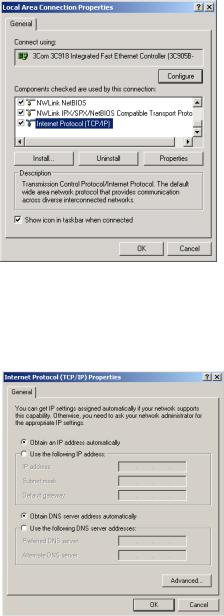
24 CHAPTER 3: SETTING UP YOUR COMPUTERS
Figure 8 Local Area Properties Screen
6Ensure that the options Obtain an IP address automatically, and Obtain DNS server address automatically are both selected as shown in Figure 9. Click OK.
Figure 9 Internet Protocol (TCP/IP) Properties Screen
7 Restart your computer.
Obtaining an IP Address Automatically |
25 |
Windows XP
1From the Windows Start Menu, select Control Panel.
2Click on Network and Internet Connections.
3Click on the Network Connections icon.
4Double click on LAN or High Speed Connection icon. A screen titled Local Area Connection Status will appear.
5Select Internet Protocol TCP/IP and click on Properties.
6Ensure that the options Obtain an IP address automatically, and Obtain DNS servers automatically are both selected. Click OK.
7Restart your computer.
Windows 98/ME
1From the Windows Start Menu, select Settings > Control Panel.
2Double click on Network. Select the TCP/IP item for your network card and click on Properties.
3In the TCP/IP dialog, select the IP Address tab, and ensure that Obtain IP address automatically is selected. Click OK.
Macintosh If you are using a Macintosh computer, use the following procedure to change your TCP/IP settings:
1From the desktop, select Apple Menu, Control Panels, and TCP/IP.
2In the TCP/IP control panel, set Connect Via: to Ethernet.
3In the TCP/IP control panel, set Configure: to Using DHCP Server.
4Close the TCP/IP dialog box, and save your changes.
5Restart your computer.
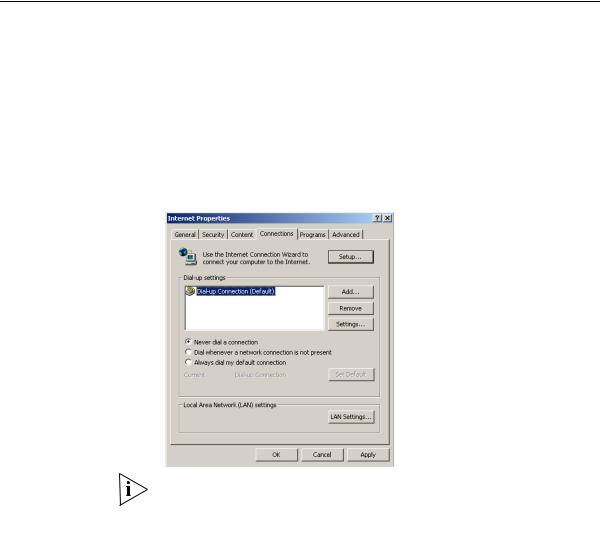
26 CHAPTER 3: SETTING UP YOUR COMPUTERS
Disabling PPPoE If you have PPPoE client software installed on your computer, you will and PPTP Client need to disable it. To do this:
Software
1From the Windows Start Menu, select Settings > Control Panel.
2Double click on Internet Options.
3Select the Connections Tab. A screen similar to Figure 10 should be displayed.
4Select the Never dial a connection option.
Figure 10 Internet Properties Screen
|
You may want to remove the PPPoE client software from your computer |
|
to free resources, as it is not required for use with the Router. |
|
|
Disabling Web |
Ensure that you do not have a web proxy enabled on your computer. |
Proxy |
|
Go to the Control Panel and click on Internet Options. Select the Connections tab and click LAN Settings at the bottom. Make sure that the Use Proxy Server option is unchecked.
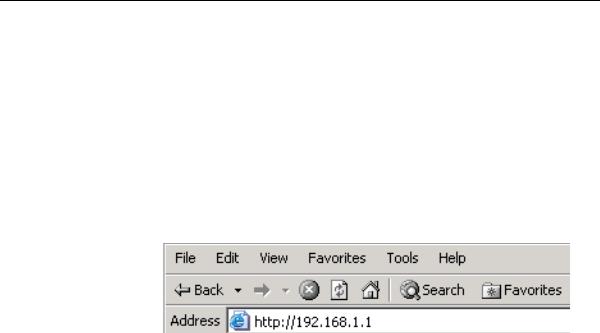
4 |
RUNNING THE SETUP WIZARD |
|
Accessing the Setup The Router setup program is Web-based, which means that it is accessed Wizard through your Web browser (Netscape Navigator 4.7 or higher, Internet
Explorer 5.0 or higher, or Mozilla 1.2.1 or higher).
To use the Setup Wizard:
1Ensure that you have at least one computer connected to the Router. Refer to Chapter 2 for details on how to do this.
2Launch your Web browser on the computer.
3Enter the following URL in the location or address field of your browser: http://192.168.1.1 (Figure 11). The Login screen displays.
Figure 11 Web Browser Location Field (Factory Default)
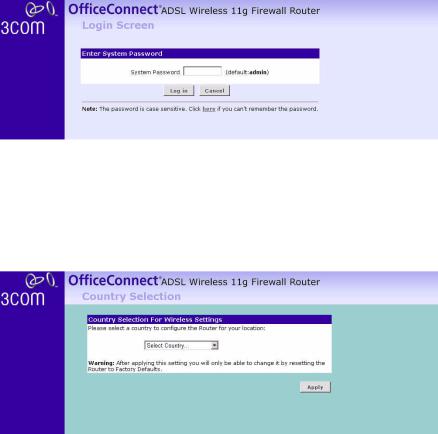
28 CHAPTER 4: RUNNING THE SETUP WIZARD
4To log in as an administrator, enter the password (the default password is admin) in the System Password field and click Log in (Figure 12).
Figure 12 Router Login Screen
5When you have logged in,
■if you are logging in for the first time, the Country Selection screen will appear (Figure 13). Please select the country form the drop-down menu, and click Apply.
Figure 13 Country Selection Screen
The Wizard will then launch automatically (refer to Figure 16). You will be guided step by step through a basic setup procedure.
■if the Router has been configured previously, the Welcome screen will appear (Figure 14). There are three tabs: Notice Board, Password and Wizard.
